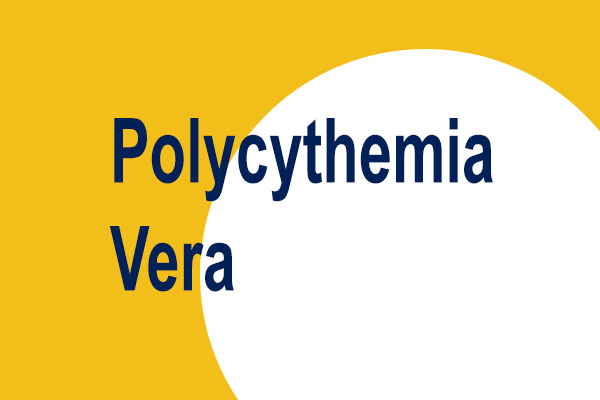Polycythemia Vera Explained
Polycythemia vera, or PV, is one of a group of progressive blood cancers called myeloproliferative neoplasms, or MPNs. This group also includes essential thrombocythemia and myelofibrosis. MPNs can affect anyone at any time, and there is no known cure.
Q: What is polycythemia vera?
A: Polycythemia vera is a chronic, progressive myeloproliferative neoplasm that is primarily characterized by an elevation of the red blood cells. The disease is most common in men over the age of 60, but anyone can develop PV. People who have PV typically experience an elevated white blood cell count, an elevated platelet count, and an enlarged spleen, especially over time.
Q: What causes PV?
A: The trigger for polycythemia vera and other myeloproliferative neoplasms isn’t known. However, researchers have discovered that PV and other MPNs may be caused by non-inherited genetic mutations affecting proteins that work in signaling pathways in cells. Nearly all people with PV have a mutation called JAK2V617F (found in the JAK2 gene) in their blood-forming cells. This mutation is one of the ways that JAK (Janus kinase) pathway signaling can become dysregulated and cause the body to produce too many blood cells.
Q: What are the symptoms of PV?
A: Like people with other types of MPNs, people who have PV may present with a wide range of symptoms, or may exhibit no symptoms at all. Common symptoms of PV include
- Headache
- Sweating
- Ringing in the ears
- Blurred vision or blind spots
- Dizziness or vertigo
- Reddish or purplish skin
- Unexpected weight loss
- Bleeding or clotting
- Early feeling of fullness
- Itching, especially after showering
- Burning and redness of hands or feet
- Fatigue
- Night sweats
- Bone pain
Q: What is the prognosis for PV?
A: Most people who are diagnosed with PV enjoy longevity if they receive regular monitoring and treatment. However, in some cases, prolonged survival can be challenged by the development of other syndromes. Approximately 15 percent of people diagnosed with PV also develop myelofibrosis, a progressive bone marrow disorder that results in bone marrow scarring, severe anemia, and enlargement of the liver and spleen. This change can be heralded by the onset of anemia, or a low red blood cell count (as opposed to high red cell blood counts), and a significant increase in the size of the spleen. In a smaller number of cases, PV may progress to acute leukemia. Additional complications that can occur with PV include arterial thromboses (heart attacks, strokes, intestinal gangrene), venous thromboses, and pulmonary embolism. People at risk of developing these illnesses should have their blood counts routinely monitored and controlled by a physician.
Q: What are the available treatments for PV?
A: Many of the treatment options for PV are designed to manage the disease by returning hematocrit levels (or the percentage of red blood cells in your blood) to normal values. However, the circumstances are different for every person, and asymptomatic individuals may not require treatment for extended periods of time. Routine monitoring by a physician is recommended for all people who have PV, regardless of symptoms. When treatment is required, common treatment options for PV include the following:
• Phlebotomy This is the removal of blood to reduce the number of blood cells. With fewer blood cells, the blood is thinner and flows more easily, improving symptoms and reducing the risk for blood clotting. This procedure is typically done to meet target blood count goals that are determined by your physician, taking into consideration your sex and other factors.
• Low-dose aspirin Most, if not all, people with PV are prescribed a low-dose aspirin treatment. Since aspirin prevents platelets from sticking together, it reduces the occurrence of blood clots that can cause life-threatening heart attacks or strokes. Combined with low-dose aspirin, the regular maintenance of a hematocrit level below .45 for men and .42 for women is currently accepted as a non-leukemogenic approach (or one that does not increase a person’s risk of leukemia) and a first-choice treatment for people with recently diagnosed, low-risk PV.
• Other medications If phlebotomy and low-dose aspirin are not effective or appropriate, or if a person is considered higher risk for blood clotting, physicians may prescribe medications to lower red blood count and relieve symptoms. These may include:
- Hydroxyurea This medicine is often prescribed for people with PV who are at high risk for blood clots, based on age and prior history of blood clotting.
- Jakafi (ruxolitinib) Jakafi is the first FDA-approved treatment for people with PV who have an inadequate response to or cannot tolerate hydroxyurea. Jakafi inhibits the JAK1 and JAK2 enzymes that are involved in regulating blood and immunological functioning. It also helps decrease the occurrence of an enlarged spleen and the need for phlebotomy. You do not need to be JAK2-positive to take Jakafi, though the great majority of people with PV harbor this mutation.
- Pegasys (pegylated interferon) Younger people and women of childbearing age who require treatment are often treated with pegylated interferon because it has not been shown to cause birth defects. Since Pegasys was developed for hepatitis C and not MPN, it is considered an “off-label” medication. Several clinical trials evaluating the effectiveness of Pegasys in people with MPNs are currently underway.
If you’ve been diagnosed with PV, it’s important to know that you’re not alone. The MPN Research Foundation provides comprehensive support for people with MPNs and their families. To learn more, visit MPNResearchFoundation.org.
Reprinted with permission from the MPN Research Foundation, MPNResearchFoundation.org.
This article was published in Coping® with Cancer magazine, January/February 2018.


